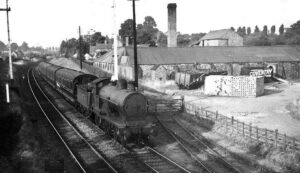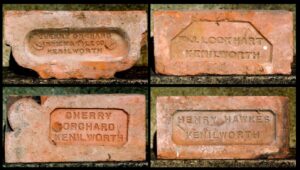Brickmaking 3rd May 2020 178/75 likes/comments
Trying to keep as much variety as I can in these articles, this time it is industry and I’m focusing on Kenilworth’s long history of brick making, as requested by Emily Godson, and Beccy Jones who lives on a brickworks site.
A large number of Kenilworth gardeners will know that not far beneath their manicured lawns and immaculate flowerbeds is a layer of red clay. This was exploited in Kenilworth for the making of bricks as far back as Roman times and ended as recently as 1977.
In 1923 a search for a possible Roman villa in Chase Woods actually revealed a Roman tile kiln; pottery was found dating to the second century. In 1957, more Roman tile fragments were found, this time at the Cherry Orchard brickworks, but a search, necessarily limited due to the location, failed to find a kiln or building. I believe these remain the only certainly identified Roman artefacts found in Kenilworth, although there are other tile fragments that could be, including one this author found in the play area in the Abbey Fields.
Often, brickworks were of a temporary nature, set up on farmland to make bricks for a particular project; a couple of such sites survived in field names such as Brick Kiln Close, now occupied by housing on the corner of Park Hill and Leyes Lane, and Brickfield at nearby Crew Farm.
As the 19th century progressed, brickworks became more permanent. One of the earliest was James Arnold’s works on the Leamington Road, in use by 1830, on a site today occupied by Bullimore Grove. Another was on Oaks farm, in operation until about 1870. Just to the south off Tanhouse Lane (Whitemoor Road) was a third, dating from the mid 1830s; this was taken on by James Arnold in 1838.
The coming of the railway in 1844 split the Leamington Road brickworks site in two; the works were eventually put up for sale in 1878, and there is no record of it in operation after this date.
All these works would have been manually operated. The earliest record of a works having mechanisation was in an 1868 report of a minor accident at the brickworks at Crackley – the site of today’s tennis club. This was probably the first mechanised industrial site in Kenilworth. From the mid 1870s this works was operated, along with a nearby quarry, by Edward Smith, a builder who amongst many buildings in town was responsible for the Local Board of Health offices, today’s’ number 6, Upper Rosemary Hill, and the waterworks building on the common, mentioned the other day. Smith’s builder’s yard was on the corner of School Lane and Rosemary Hill, his storeroom was incorporated into the construction of Rosemary Mews.
In 1872, Walter Lockhart took on the lease of a small brickworks at Whitemoor and produced the first Kenilworth bricks known to have carried the town’s name. Lockhart installed a railway siding into his works and Kenilworth brickmaking at last became a major industry. Briefly in the 1880s the works was taken over by the Leamington & Lillington Brick Company before being taken on by Henry Hawkes, a member of the Stoneleigh family who had owned the land throughout the brickmaking years.
In 1881, Thomas Hawley, who lived at Park Hill, successfully applied to build brick-kilns on land he owned that was then in use as a market garden known as The Cherry Orchard. It was to be seven years until the kilns were put up, in the name of a company called Mason and Dall; a railway siding was quickly added. The brickworks, soon renamed The Cherry Orchard Brick Company, initially took up only part of the site, the market garden continued for a number of years afterwards. These two brickworks with their railway sidings became key businesses in a developing Kenilworth.
Not surprisingly, the brickworks were perhaps the most dangerous of places to work in Kenilworth. Accidents ranged from a young lad who caught his leg in the revolving ‘knives’ that thrashed the clay and had to have his leg amputated up to his thigh, to a man who died when a new boiler fell on him. Even away from the machinery workers were not safe; in the pits, clay-falls regularly caused broken bones, one man lost three fingers when a stick of dynamite blew up in his hand, and another died from sunstroke. All this and more in just a twenty-year period at the end of the 19th century.
The 20th century saw the Cherry Orchard and Whitemoor brickworks firmly established with good reputations, the Cherry Orchard in particular for engineering bricks. During WW2, the drying sheds were used for wartime storage and even small parts production. In the early post-war years, the Cherry Orchard was rebuilt using prisoners of war for labour, but the Whitemoor works did not modernise and closed in the mid-1950s. The Cherry Orchard continued until 1977; the pits of both works were used to dump the rubbish from the houses, many of which were made from the clay dug from those same pits. The last of many buildings in town certain to have been built with Kenilworth bricks are the flats known as The Towers on Park Hill; about a fifth of a million of them were delivered to the site from Cherry Orchard.
Ebourne Close was built on the site of the Whitemoor works in 1982, and Cherry Orchard on the site of that works in 1988.
Far more detailed accounts of Kenilworth’s brick industry can be found in my Kenilworth’s Railway Age and Victorian Kenilworth books.

A photograph from the Gordon Coltas collection that epitomises a long-lost era in Kenilworth’s industrial past; in 1938, a steam hauled passenger train passes the smoking chimneys of the Cherry Orchard Brickworks, now the site of the re-cycling centre.

And a selection of Kenilworth-made bricks from my collection.